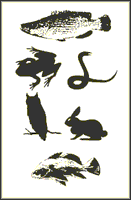Nebraska Cooperative Fish and Wildlife Research Unit

Nebraska Cooperative Fish and Wildlife Research Unit: Staff Publications
Date of this Version
2016
Citation
Ecology of Freshwater Fish 2016: 25: 99–108
Abstract
Non-native trout are currently stocked to support recreational fisheries in headwater streams throughout Nebraska. The influence of non-native trout introductions on native fish populations and their role in structuring fish assemblages in these systems is unknown. The objectives of this study were to determine (i) if the size structure or relative abundance of native fish differs in the presence and absence of non-native trout, (ii) if native fish-assemblage structure differs in the presence and absence of non-native trout and (iii) if native fish-assemblage structure differs across a gradient in abundances of non-native trout. Longnose dace Rhinichthys cataractae were larger in the presence of brown trout Salmo trutta and smaller in the presence of rainbow trout Oncorhynchus mykiss compared to sites without trout. There was also a greater proportion of larger white suckers Catostomus commersonii in the presence of brown trout. Creek chub Semotilus atromaculatus and fathead minnow Pimephales promelas size structures were similar in the presence and absence of trout. Relative abundances of longnose dace, white sucker, creek chub and fathead minnow were similar in the presence and absence of trout, but there was greater distinction in native fish-assemblage structure between sites with trout compared to sites without trout as trout abundances increased. These results suggest increased risk to native fish assemblages in sites with high abundances of trout. However, more research is needed to determine the role of non-native trout in structuring native fish assemblages in streams, and the mechanisms through which introduced trout may influence native fish populations.
Included in
Aquaculture and Fisheries Commons, Environmental Indicators and Impact Assessment Commons, Environmental Monitoring Commons, Natural Resource Economics Commons, Natural Resources and Conservation Commons, Water Resource Management Commons


Comments
US govt work